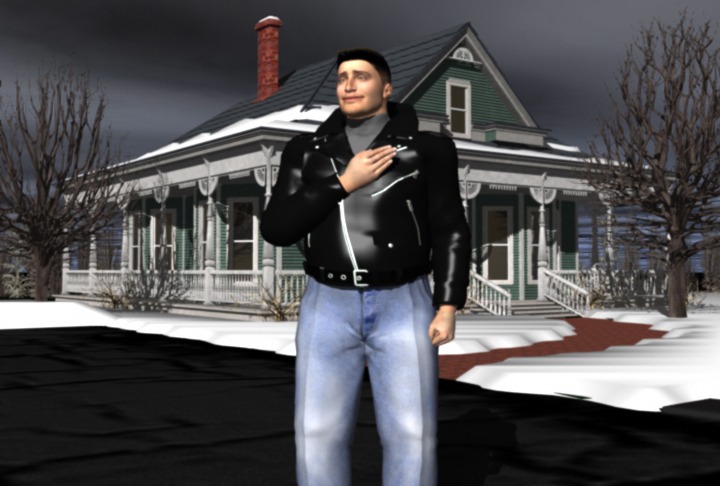
The Animated World We Live In
Written by Scott R. Caseley | Posted by: Anonymous
Politics these days closely resemble the circus. Many attractions go on at once and it all makes sense as one entity if you look closely enough, or through the right lens. Jim Connell’s film, Saul Goodman, is told through the lens of a politically savvy ringmaster who crosses paths with a seemingly uninterested and apathetic young man at Boston’s North Station.
Connell began tinkering with filmmaking at the age of 10 while growing up in Westford, Massachusetts. He used a Super-8 camera and shot projects with his brother Paul. The majority of these early works were doomed to come out black because the two of them hadn’t yet figured out the value of exposure. At 15, his first foray into narrative structure was with a cartoon epic about Charles Manson and his slaughter of six individuals in Political Piggies.
He graduated from Merrimack College with a degree in political science and a minor in fine arts. During his time there, he got involved in the production of numerous TV endeavors including sketch comedy. With the acting support of many fraternity brothers, he was able to write, produce and direct several episodes of a comedy show. It was also there that he became acquainted with John Cammarata, who portrays the aforementioned gentleman in Saul Goodman. Connell says Cammarata is, "an incredibly gifted versatile and intuitive actor."
Connell then went on to a year at Emerson College where funds quickly dried up. He decided then and there that he would rather go broke making a movie than go broke sitting in a classroom learning how to make a movie. During production of his first student film, Hellion, he met Eric Scheiner, the other lead actor in Saul Goodman. Of Scheiner, he says that he is "a fantastic leading man, but he also has this amazing radio voice with great depth and range." NewEnglandFilm.com recently caught up with Connell for an interview.
Scott Caseley: Your film has a run-time of just under a half hour, yet you tell an intricately woven tale involving political corruption, media manipulation, and using science for political gain. Where did this idea spring from?
Jim Connell: The two-page outline for Saul Goodman, where two strangers exchange seemingly random stories that piece together a puzzle, I wrote back in college. While writing the full script a few years back, I read up on political campaigns, conspiracy theories and urban myths to get ideas for the three stories that fit into this framework. I realized that very aggressive, stylized dialogue would be needed to stitch everything together seamlessly and that was the toughest thing to write. It helped to watch work from great dialogue writers like Mamet, Tarantino and Aaron Sorkin (for my money, seasons 1-5 of The West Wing are like one 90-hour-long dialogue workshop).
SC: The focus is on the backdoor dealings of an ambitious Senator running for President of the United States and begins at 1:20 am, also the numeric date designated for inauguration. Was this a coincidence or was it a symbolic choice?
Connell: I’m tempted to say that this was intentional, but that was a happy accident. 1:20 am was just a time the two characters were sure to be alone. I did hide other little tidbits in there, like the phone company that pops up throughout the movie, ‘Dorin Telecomm,’ which is named after my lovely wife Dorin. Another company, ‘Goldbrick Industries’ played a central part in a previous film of mine called Placebo.
SC: When doing a political story, you could have easily made it the conventional live action way. Why did you decide on doing it completely CGI?
Connell: I had really large-scale stories in mind, featuring a cast of thousands, dozens of explosions and massive forest fires that I would never have found the budget to re-create with live action. For the third act in particular, I wanted the secret government fusion laser lab to be ridiculously huge, and its destruction to be epic in scale. The CGI allowed me to visualize whatever came out of the character’s mouths, whether it was Area 51 or a colonial New England town. It was quite liberating.
SC: What were some of the bigger challenges from doing a strictly CGI short? And, to contrast, what were some of the benefits from doing it completely in this format?
Connell: The biggest challenge is to get the characters to move and act as naturally as possible. Being a one-man operation on a small budget, I didn’t have access to motion capture technology or a team of character animators like most big studios do. As a result, I wasn’t able to get the movements and facial expressions as natural as I would have liked. On the other hand, the CGI opened up a wide range of options for telling the story. I was able to design the characters and sets just as I wanted and use as many special effects, explosions, weapons and extras as I felt like.
SC: From conception to completion, how long did the project take?
Connell: About 2 1/2 years working part time. Most of that time was consumed with the rendering process, which was incredibly slow.
SC: Many subjects that are in the public consciousness are addressed — celebrities preaching abstinence, campaign financing, red states versus blue states, etc. What were some of your influences on how these topical things were to be portrayed?
Connell: When writing the Old Man’s tall tales, I wanted to include some cultural touchstones that the audience would recognize. Allusions to the red/blue state divide, Britney Spears and the Unabomber, along with references to real life events, like the forest fires that damaged the Los Alamos government labs in 2000, gave the Old Man’s stories an air of credibility. Most conspiracy theories are based on facts, not fictions. What makes them crazy is how those facts are connected, and what conclusions are drawn from those connections.
SC: A major plot point deals with the creation of an imaginary synthetic primary color that stirs an active interest in the media and the American public at large. What did this invention symbolize to you?
Connell: For me, this invention represents what happens to things beautiful and pure when they’re politicized and commercialized. The beauty that this invention would bring the world was cynically exploited, abused, then abandoned by the powers that be who never saw it as anything more than a means to an end.
SC: The names of almost every character are disclosed with the near exception of your two leads. Why was this decision made?
Connell: The conversation that strikes up between the two main characters is meant to come off as random and spontaneous. The fact that they never exchange names or formally introduce themselves adds to this sense of randomness, but could also be intentional on the part of one of the two. Also, this movie is essentially about the identity of Saul Goodman, so I was careful not to identify any character I didn’t have to so as to leave them on the list of possible suspects.
SC: Your characters are a politically savvy elderly gentleman and math whiz from MIT; what about these traits made these types of individuals an ideal match-up?
Connell: The two men represent opposite archetypes that the audience will recognize. The Old Man’s a cagy, seasoned, political operative with a deep understanding of power and realpolitik, while the Young Man is a cynical, sarcastic product of the information age. The Young Man’s reliance on science and logic make him a perfect foil for the Old Man, whose worldview is shaped by experience and gut instinct. Having the Young Man challenge the tall tales in real time, with expert analysis, also puts him on the side of the audience, giving voice to their inevitable skepticism.
SC: Given the many twists and turns that your audience is expected to go on during this journey of reflection then revelation, and finally retribution, what films inspired your work?
Connell: In terms of story and structure, the most obvious inspiration is The Usual Suspects, but in terms of tone and content, another big inspiration is Oliver Stone’s JFK. It’s masterful the way Stone is able to communicate massive amounts of forensic, legal, and political information in an entertaining and compelling way. I borrowed a few stylistic elements from JFK, like the washed-out, overexposed lighting used in the book store, and I even asked our composer, Ricardo Poza, to incorporate into our score some of the same musical instruments used in JFK to give it the same conspiratorial feel.
Scott R. Caseley, a hyperactive-hyphenate is following up last year’s debut of his feature film, Larry’s Home Video, by being associate producer/director for the television show Hollywood New England, co-writer/director of the documentary, Unconditional Love, and is always looking for new challenges on-set, on location, or in life in general.
Jim Connell’s short, Saul Goodman, screens at the Boston Underground Film Festival, which runs March 22-25 in Harvard Square. To learn more about BUFF, visit http://www.bostonundergroundfilmfestival.com/. Visit the Saul Goodman homepage at http://www.saulgoodman.net/. Scott R. Caseley, a hyperactive-hyphenate is following up last year's debut of his feature film, Larry's Home Video, by being associate producer/director for the television show Hollywood New England, co-writer/director of the documentary, Unconditional Love, and is always looking for new challenges on-set, on location, or in life in general.











